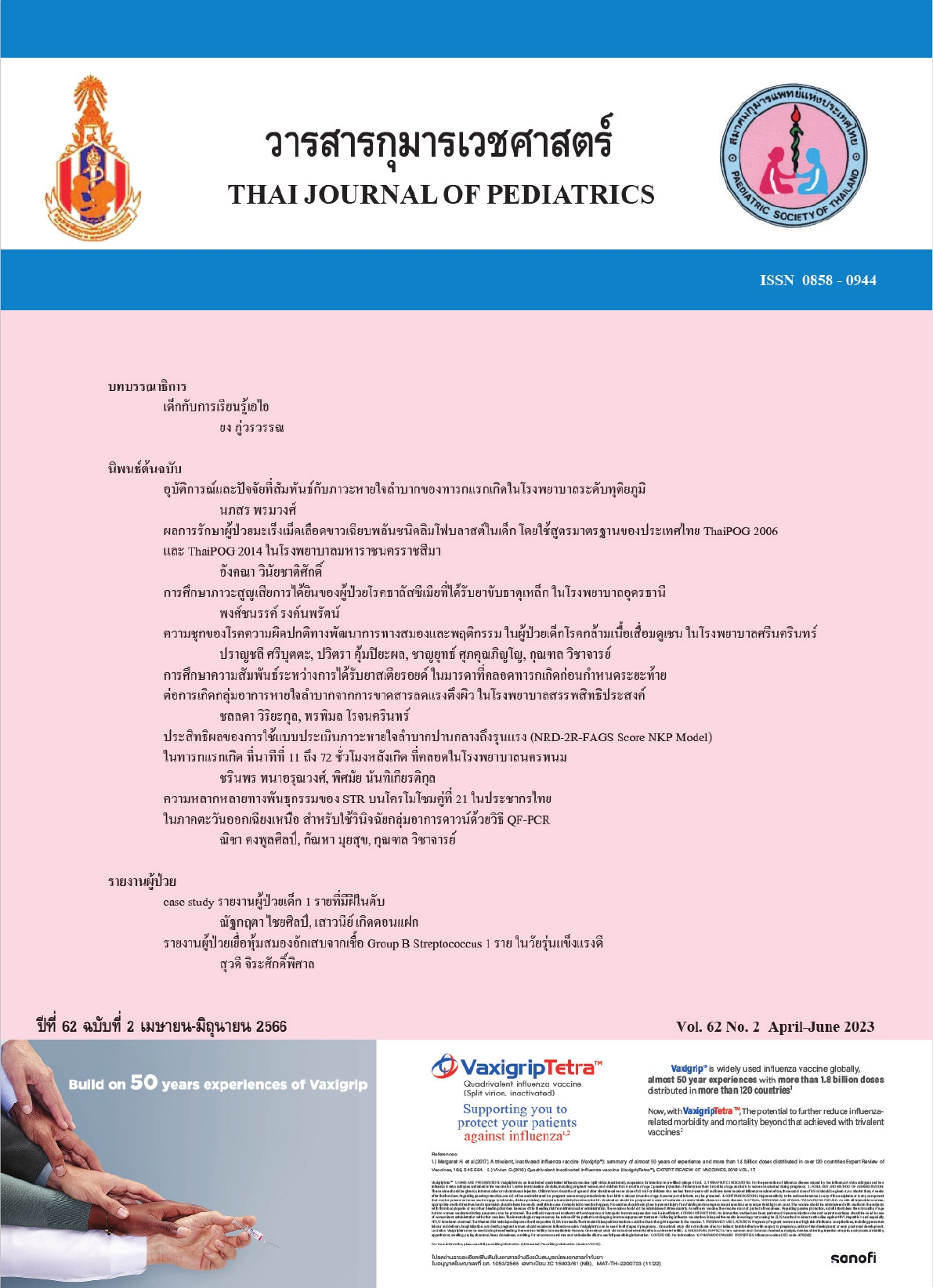Prevalence of Neurodevelopmental Disorders in Children with Duchenne Muscular Dystrophy in Srinagarind Hospital
Keywords:
Duchenne Muscular Dystrophy (DMD), Intellectual disabilities (ID), Intellectual quotient (IQ), Autistic spectrum disorder (ASD), Attention deficit hyperactivity disorder (ADHD)Abstract
Background: Duchenne Muscular Dystrophy (DMD) has an association with neurodevelopmental disorders, such as Intellectual disabilities (ID), Autistic spectrum disorder (ASD) and Attention deficit hyperactivity disorder (ADHD). These comorbidities are an important factor affects DMD patient’s quality of life.
Objectives: To define the prevalence of neurodevelopmental disorders and genotypephenotype correlation in Thai children with DMD.
Methods: A descriptive cohort study, Neurodevelopmental disorders were evaluated in Thai DMD children under 18 years old in Srinagarind hospital. Development and behavioral problems were evaluated. ASD and ADHD were screened. IQ was evaluated by clinical psychologist. Making a diagnosis of neurodevelopmental disorders was established by developmental-behavioral pediatrician using DSM-5 criteria. Genotype-phenotype correlation was evaluated.
Results: Twenty Thai boys with DMD were enrolled. The median age was 9.5 years. Twelve patients (60%) had ID, one patient had both ASD and ID, one patient had both ADHD and ID. Seven patients (35%) had mild ID (IQ 50-69), 5 patients (25%) had moderate ID (IQ 36-49), 4 patients (20%) had borderline IQ (IQ 70-79), 3 patients (15%) had low normal IQ (IQ 80-89), and 1 patient had normal IQ (IQ>90). Median IQ of all patients was 68.0 (IQR 62.0, 81.0). Eleven patients (64.7%) have deletion/duplication of DMD gene. No statistically significant correlations between genotypes and level of IQ and types of neurodevelopmental disorders were identified.
Conclusions: The prevalence of ID in children with DMD is high while ASD and ADHD are less common. The association of genotype and cognitive functions and behavioral problems in children with DMD remains unclear.
Downloads
References
Crisafulli S, Sultana J, Fontana A, Salvo F, Messina S, Trifirò G. Global epidemiology of Duchenne muscular dystrophy, an updated systematic review and meta-analysis. Orphanet J Rare Dis. 2020; 15: 141.
Thangarajh M, Hendriksen J, McDermott MP, Martens W, Hart KA, Griggs RC. Relationships between DMD mutations and neurodevelopment in dystrophinopathy. Neurology. 2019; 93(17): 1597-1604.
Hendriksen JGM, Vles JSH. Neuropsychiatric disorders in males with Duchenne muscular dystrophy: frequency rate of attention-deficit hyperactivity disorder (ADHD), autism spectrum disorder, and obsessive compulsive disorder. J Child Neurol. 2008; 23: 477-481.
Banihani R, Smile S, Yoon G, et al. Cognitive and neurobehavioral profile in boys with Duchenne muscular dystrophy. J Child Neurol. 2015; 30: 1472-1482.
Wingeier K, Giger E, Strozzi S, et al. Neuropsychological impairments and the impact of dystrophin mutations on general cognitive functioning of patients with Duchenne muscular dystrophy. J Clin Neurosci. 2011; 18: 90-95.
Prosser EJ, Murphy EG, Thompson MW. Intelligence and the gene for Duchenne muscular dystrophy. Arch Dis Child. 1969;44: 221-230.
Smith RA, Sibert JR, Harper PS. Early development of boys with Duchenne muscular dystrophy. Dev Med Child Neurol. 1990; 32: 519-527.
Parsons EP, Clarke AJ, Bradley DM. Developmental progress in Duchenne muscular dystrophy: lessons for earlier detection. Eur J Paediatr Neurol. 2004; 8: 145-153.
Cyrulnik SE, Fee RJ, De Vivo DC, Goldstein E, Hinton VJ. Delayed developmental language milestones in children with Duchenne’s muscular dystrophy. J Pediatr. 2007; 150: 474-478.
Connolly AM, Florence JM, Cradock MM, et al. Motor and cognitive assessment of infants and young boys with Duchenne Muscular Dystrophy: results from the Muscular Dystrophy Association DMD Clinical Research Network. Neuromuscul Disord. 2013; 23: 529-539.
Darmahkasih AJ, Rybalsky I, Tian C, et al. Neurodevelopmental, behavioral, and emotional symptoms common in Duchenne muscular dystrophy. Muscle Nerve. 2020; 61: 466-474.
Bladen CL, Salgado D, Monges S, et al. The TREAT-NMD DMD global database: analysis of more than 7,000 Duchenne muscular dystrophy mutations. Hum Mutat 2015;36:395–402.
Orsini M, Carolina A, de Ferreira AF, et al. Cognitive impairment in neuromuscular diseases: a systematic review. Neurol Int 2018;10:7473.
Doorenweerd N. Combining genetics, neuropsychology and neuroimaging to improve understanding of brain involvement in Duchenne muscular dystrophy - a narrative review. Neuromuscul Disord 2020;30:437– 442.
Downloads
Published
How to Cite
Issue
Section
License

This work is licensed under a Creative Commons Attribution-NonCommercial-NoDerivatives 4.0 International License.



